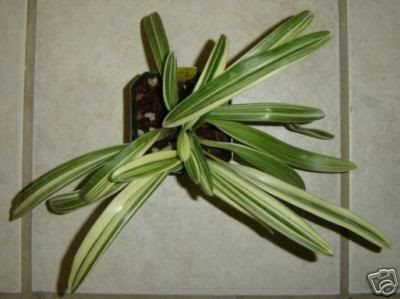It's a genetic mutation that causes a stable variegation on the leaves or areas lacking chlorophyll. It's quite rare on some species. Some Japanese species have various 'registered' clones/cultivars with varigation such as Dend moniliforme and Neofinetia falcata (fuukiran). And there are also various cymbidium cultivars with noted variegation.
An auction for a variegated Paph insigne in the USA was sold for $377.77

I stole this photo from the auction

I believe a variegated 'Paph. insigne var. variegatum 'Doris Dukes'' was sold in Japan for $30 000 (I don't have a photo of that most expensive orchid)...Quite a collectors plant for the rich since they can't be mericloned. In Japan there's quite a demand for variegated plants too.(If you haven't noticed most of the variegated orchid cultivars are asian)
..........I wanted that paph insigne for auction, it also had a bloom similar to that of insigne var. sanderae. I would have to get it past the border and I only wanted a smaller division of it so I would have to pay that much. Some forum buddies in the states were bidding on it to share a piece with me...They were reluctant to pay the high price until the auction ended and they realized the plant would divide and pay for itself. It was a competitive auction ending...the price rose by at least a hundred in the last 30 secs.
Phrag. Sorcerer's Apprentice `Fox Valley Variegate' recieved a JC/AOS and it's very variegated, even the bracts on the spikes
Any variegated slipper would make me happy. I heard they are a more common occurrance in phrags, but I do not know why (probably a genetic thing) Some variegation is more stable than others too,its all genetic. Some plants can revert back to normal foliage under poor culture or low light.
Also nutrient deficiencies and viruses can cause variegated leaves, but that's different
The phal shown above has been mericloned and sold.


























 I stole this photo from the auction
I stole this photo from the auction
 I've spent over a little of $100.00 on a paph, $30,000 is slightly out of my price range!
I've spent over a little of $100.00 on a paph, $30,000 is slightly out of my price range! 







 Linear Mode
Linear Mode


